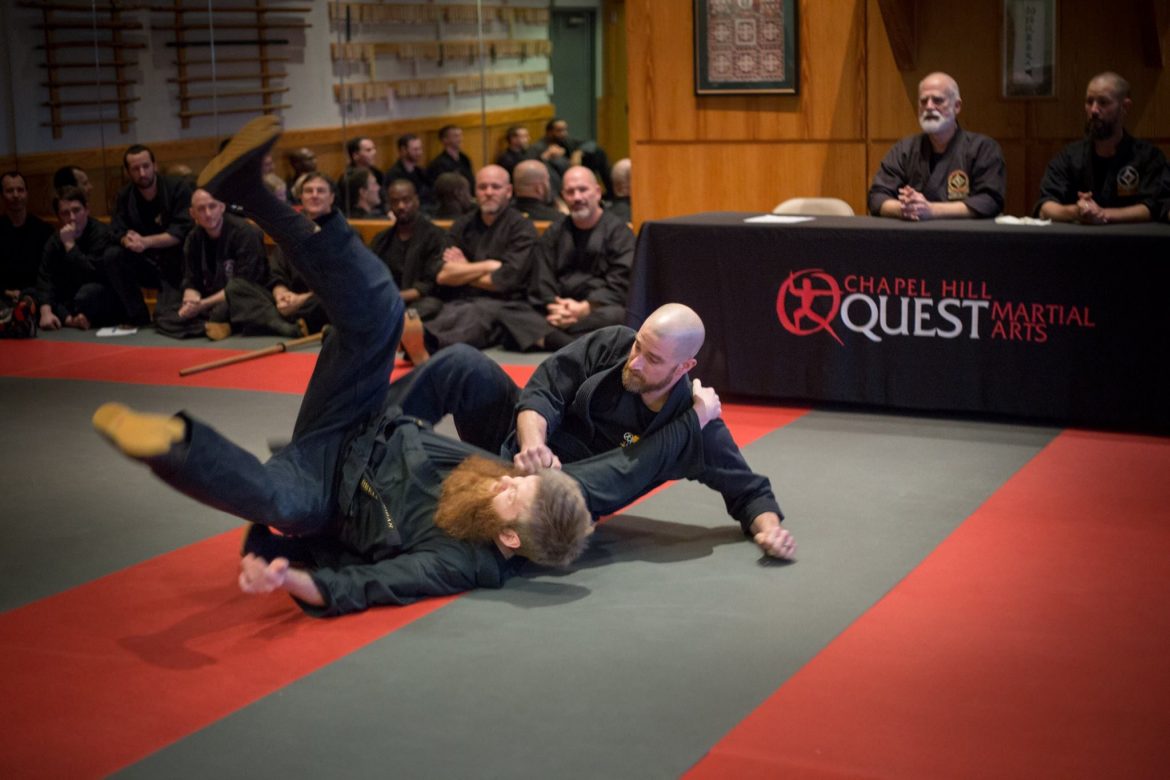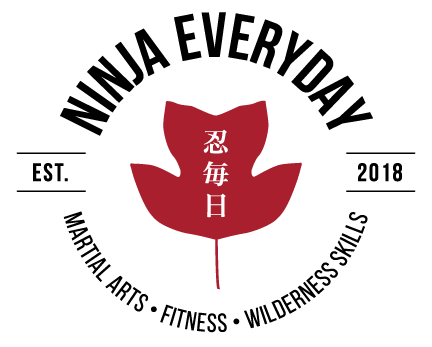 Nov
27
Nov
27
Jiu-Jitsu at Chapel Hill Quest Martial Arts
- November 27, 2018
- 0 Comment(s)
Jujutsu is the typical American spelling referring to the older Japanese practice of grappling based martial arts. Judo is a sport that is made up of movements taken from Japanese Jujutsu and practiced under a specific set of rules that favor the throwing part of the art. Jiu-Jitsu is the spelling that most people use when they are describing Brazilian Jiu-Jitsu, BJJ for short, which is often (not always) expressed in a sport context and uses jujutsu techniques under a specific set of rules that favor techniques on the ground, particularly “submission techniques”. Ju-taijutsu is the phrase that most people who train in To-Shin Do, taijutsu, or ninja style martial arts, use to describe the grappling aspect of their study. There are several “name brand” distinctions (they are very important to some people), but all in all these things are different ways to describe Japanese inspired “wrestling” or “grappling” techniques. Standing throws, locks, and chokes along with defenses, escapes, and attacks on the ground are present in all of these practices but with different emphasis placed on different areas.
For the sake of simplicity I am going to use the word “Jiu-jitsu” to describe what I am talking about and what we are going to be doing at the Chapel Hill Quest dojo. “Jiu-jitsu” as a word, for me, encompasses the Japanese Jujutsu/Ju-taijutsu techniques, the innovations and adjustments to those techniques that I learned from my continued study of Brazilian Jiu-Jitsu, and the wrestling techniques and strategies that I focused on to improve my “no-gi” effectiveness and general grappling awareness.
I have personally been training martial arts for twenty years. For sixteen of those twenty I have been practicing jiu-jitsu in one form or another. I have had times where I have trained just once per week, times where I trained two or three times per week, and several years of six or more times per week. I’ve trained in Brazilian Jiu-Jitsu, wrestling for fighting, classical Japanese jujutsu styles like Takagi Yoshin Ryu and Shinden Fudo Ryu, and attended countless seminars and training opportunities with masters of these disciplines.
Chapel Hill Quest Martial Arts as a dojo has had a strong history with jiu-jitsu through out its twenty year existence. With To-Shin Do as our primary martial art, we have always had the Nage-Waza (throwing techniques) and classical ju-taijutsu as part of our training. For several years we ran a program that we just called “Ju-taijutsu” that was in essence a “no-gi” jiu-jitsu class. Currently, as part of our rotating class schedule, we offer a class called “Quest Ground Tactics” that is a “no-gi” jiu-jitsu class. Our school even hosted and helped to found a jiu-jitsu academy that has since moved on. In short, our jujutsu history is a big part of what makes us unique as a To-Shin Do dojo.
I personally love having jiu-jitsu as part of my training practice. I see so much value in the timing and sensitivity that it develops. I’ve seen and felt it enhance my own personal taijutsu capabilities. I’ve increased the number of situations that I could potentially respond to because of my jiu-jitsu.
I do hear taijutsu practitioners coment occasionally that there is “too much muscle or athleticism used in jiu-jitsu” and “I don’t want to develop bad habits by fighting on the ground”. To the first objection I say that most jiu-jitsu that you see is shown in a sporting context where both of the competitors are the same size, age, and experience level. If you placed someone with experience in an altercation against someone without jiu-jitsu knowledge, the need for athleticism and strength is so reduced because of the technique discrepancy. Imagine a professional boxer fighting a complete novice, it would require no effort whatsoever. To the second objection I would say that you don’t have to train jiu-jitsu in a way that would lead to bad habits or a predisposition for taking your fight to the ground. For example, as a self-defense focused practitioner I favor the “knee-on-belly” position over other types of mounted positions because it allows me to get back to my feet quickly and it is a very effective platform from which to strike. I spend a lot of my training energy on sweeps from the bottom instead of submissions because again I would rather be on top and able to break contact if I need to. I do lots of drills that allow me to practice and emphasize getting back up to my feet and I personally don’t believe that a fight has to go to the ground. I do want the ability for myself and my friends to be able to handle a fight wherever it takes place. So many people avoid this kind of training and ultimately it results in a sense of panic if they do get taken down and can’t immediately get back up. Jiu-jitsu training lets you stay calm and make good decisions in what is a very uncomfortable situation for most people. The jiu-jitsu training that I am interested in focuses on technique development, balance taking and manipulation, leverage over strength, timing over speed, and expanding my “use of force continuum”.
Because of these benefits and as part of my duty as a martial arts instructor we are going to offer jiu-jitsu specific training at the Chapel Hill Quest Martial Arts dojo. I believe it is part of my duty because it has contributed so much to the martial artist that I am, and that my charge as dōjōchō (dojo chief) is to create the most highly skilled black belts possible. My other duty is to uphold the integrity of To-Shin Do, it’s movement concepts, and our primary goal of developing practical and usable self-protection skills. I know from personal experience that these two styles can flourish in the presence and with the influence of each other, but I would like people’s participation in the jiu-jitsu training to be voluntary. No less emphasis will be placed on To-Shin Do as we grow in this direction. In fact my goal is for this additional training is to allow for a “deep dive” into this area of study and to complement our To-Shin Do training by providing an opportunity for our students and friends to mesh and synchronize these technologies.
We are going to place a few “official” jiu-jitsu classes in the schedule. We will send out an email to our Quest students with information about that class and class times. As I am not a black belt in jiu-jitsu yet, we have to operate under the guidance of a higher ranked instructor and I have decided to work with Jiu-Jitsu Sandan, Professor Roy Dean, who has influenced my jiu-jitsu journey since I began. Professor Dean’s background in multiple traditional classical Japanese styles (Aikido, Judo, and Japanese Jujutsu) along with his Brazilian Jiu-Jitsu credentials make him the clear choice to guide me, and by extension you, through this powerful art form.
In the past when we have had both To-Shin Do and Jiu-Jitsu communities, we experienced a clash in cultures and direction. Now under one banner, as part of one family, we can offer this training to all of our members. Class participation will operate like our Quest Fit and Quest Kick options for our martial arts members, they are there to make you better and to help supplement your training on your way to unleashing your potential, but again, completely voluntary. My intention is not to treat this as us offering two martial arts but rather offering another opportunity to increase our martial arts education and an opportunity to grow in our capacity as protectors.
Ninja Every Day.
